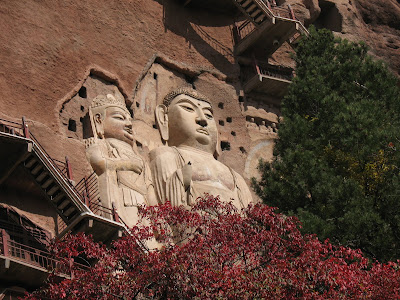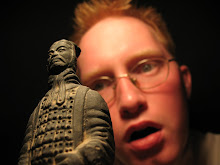MaijiShan Retreat
All the wonderful things I have seen this weekend in Baoji and Tianshui were mere appetizers for the main course served at MaijiShan National Park. And like any proper feast, MaijiShan offers something for everyone--culture, history, scenery, and yes even shopping. Like deciding between the turkey and sweet potato caserole at Thanksgiving, it's difficult to say which is the bigger highlight of MaijiShan--the culture or the scenery? But it's really a moot question... devour them both!
What is MaijiShan? Well let's start with a translation and then move to the important info. "Shan" means mountain. MaijiShan is a "mountain"... er, mountainlike hill really. "Maiji" means wheatstack. So it's a hill that looks like a wheat haystack.... I'm taking you on a tour of a hill that looks like a haystack... stay with me though...
I've been calling this series "A Silk Road Adventure," or something like this. In truth, MaijiShan is the only bonefied Silk Road site of the weekend. It was my focal destination.
The Silk Road was a network of trade routes that connected the Far East (not just China) with the Far West and all points in between. These routes traversed some of the most unwelcoming and truly deadly terrain on the face of the planet. Those who embarked on the journey faced the mountains, deserts, extreme temperatures, and mile-after-mile of tread and isolation that separated the dispersed societies of the globe. For those who survived, trade was their cherished reward. And everything was traded... everything... material goods to spiritual enlightenment. Globalization before our time!
MaijiShan symbolizes all of this. Man has been carving reflections of Buddhist faith and spirituality into the steep cliffsides of MaijiShan for centuries. Buddhas, Boddhisatvas, and other figures are presented on the face of MaijiShan via massive carvings, elaborate frescoes, and hundreds of grottoes with clay sculptures. Where did all of this come from? The Silk Road.
First, the very presence of Buddhism in China owes to the Silk Road that brought it--its philosophies, its art, its texts, its stories--from their origins in South Asia to their destination on MaijiShan. But these carvings, grottoes, and frescoes plastered at great heights onto the steep side of a solid mountain must have been expensive. Who could afford them? We know that an assorted collection of rich and powerful notables from the Northern Dynasties of 1500 years ago up to the Qing Dynasty of the last century commissioned the creation and repair of this artwork. I surmise that their money and their power derived--to varying degrees across time and circumstance--from the resource wealth gained from Silk Road trade. Because of the trade, people could afford to construct MaijiShan art. MaijiShan's development flows from the Silk Road in a final, important way. MaijiShan served a purpose... travelers leaving Xi'an toward the frightening treacheries of Central Asia stopped at every oasis to recollect and reflect; MaijiShan and the forested hills that suround it gave such travelers their first significant oasis. They stopped at MaijiShan to gather themselves and pray--with gratitude for their survival so far but mostly with pleadings to survive the much greater hardships that lay beyond Tianshui.
MaijiShan would be an unremarkable, plain-faced, haystack-looking mountain without the Silk Road. Instead, it is a world treasure. Let's take a look...
Let me clarify one thing. MaijiShan is a mountain. MaijiShan National Park is a massive area with numerous natural and cultural attractions--of which MaijiShan itself is but one attraction. When you arrive at the park entrance (take a bus from the train station to the park for less than 10 kuai!) and after you have paid your 70 kuai to enter, you wonder, "now what?" There's just a road! It turns out there is a very long distance from the entrance of the park to the entrance of MaijiShan. Just follow the road--the paved road only--up and up until you see MaijiShan. You can take a mini-bus up the road, but even then it doesn't bring you all the way to MaijiShan. And I have no idea how much its costs, because I decided to walk the road. Either way, just keep walking up and up. The walk is looooooong... but if you come in the right season, it is well worth it.
In fact, the lonely walk on that road at the height of Autumn seriously competes with MaijiShan itself. Whereas Autumn has been bland in my town of HuaiYa, Autumn has painted itself all over MaijiShan National Park. And because you are at the foot of towering mountains, you get to enjoy panoramic views that stretch wherever you point your eyes. One week ago, I surrendered myself to the conclusion that I was going to have to survive a year without Autumn. And then this weekend came, and I encountered the most spectacular Autumn that I have ever witnessed in my entire life. It's my own twist on that Ray Bradbury story... we can call it "All Autumn in a Day."
At the entrance of MaijiShan National Park, I know I am in for a treat!
Walking up to MaijiShan, my soul soaks in the oranges and yellows and reds and browns... the blue skies... the freshly chilled air. What was an oasis of Buddhist spirituality for those before is an oasis of Autumn spirituality for me.
This is MaijiShan. When you see this "haystack-looking mountain," you will know that you have arrived at the right place... as opposed to the handful of other beautiful places you might accidentally land in if you take a detour from the paved road that brings you here.
The Buddhist artwork of MaijiShan is painted and carved onto the sides of the cliff. So take the stairs straight up!...How did you think you would were going to see it all?!
A complex network of stairs is part of the wonder of MaijiShan. They bring you face-to-face with the true wonders of MaijiShan... massive carvings into the walls as well as a honeycomb of grottoes each containing miniature (or in some cases life-sized) clay figures.

The grandness of the carvings are revealed by the smallness of the people admiring them at their feet.
The large Buddha and His Bodhisattvas... this is arguably the central attraction of MaijiShan.

the Enlightened One reflecting brilliance

the grand trio, up close and personal
You cannot take pictures of or within the grottoes, but I snapped this pic of my favorite grotto from the foot of the hill... this flashless picture from far away cannot do more damage to the grotto than the intensity of the sunlight streaming in through the windows. Each grotto is protected by a wooden door with a screen window. You cannot walk inside... you cannot reach inside... you can barely even look inside. I don't know how anyone could take a picture up close anyways. In any case, it is illegal and there are security devices on the prowl.

Although some of MaijiShan's carvings and grottoes are as lively and mint as if they had only just been crafted yesterday, others have been utterly devastated by vandalism, earthquakes, the elements, and time. In some grottoes, the figures are missing hands and heads; through large chest cavities you can see the internal wood framework; some grottoes are empty of all but the nearly-invisibly imprint of a former work of art. So when you walk... er climb... around MaijiShan, you will witness the park's efforts at repair. In some cases, entire sections of the hill are closed off for repair. I hope someday this place will be restored to fuller access... your 70 kuai entrance fee is going to a worthy cause!
This Buddha's right-side companion is almost entirely gone... are these wooden posts evidence that the park is planning to place a new Boddhisattva here? What an incredible project!
Visiting MaijiShan might not be so enjoyable for someone who is afraid of heights. Then again, I myself suffer a tad uneasiness with heights yet found the experience thrilling. Don't look down... just look at the Buddhas...

But if you can at all afford to look down and out, you will be rewarded... the view is amazing. Mountains, valleys, autumn colors, winding paths, and distant villages nestled in the niches of it all. Buddhas to one side and an awe-inspiring viewscape to the other... speechless serenity!

take me away!

I love MaijiShan in the Autumntime!
magic
The retreat is over. I lack the time to head further West along the Silk Road toward the "Go In and You'lll Never Come Out" Desert. So it's back along the Silk Road to HuaiYa... back to the Autumn Desert where water is plentiful but orange and red are in fatally scare supply.

















3 comments:
Aaron!!! Oh my Buddah!! This is magnificant! I want to go!!! Can we plan a trip? How far is this? Details Plz!
Awesome, awesome, awesome! And I thought our colors were beautiful this year. Now you may be bored for the rest of your Autumns in America? That third to last pic makes me jealous.
Magnificent/colors are captivating! I know how much you enjoy Autumn,looked like you picked a perfect day to go.What detail in the carvings, just not sure about climbing those stairs! I'm glad to hear that China restores and preserves their HISTORY. It would be a shame to let that go. One can only imagine all there is to see out in this world, sooo happy you're getting to experience a small part.
Keep on traveling and enjoy
every moment on your journey.This Nat Park was breathtaking by pictures,how awesome to be there in person. Look forward to more travel blogs!
Post a Comment